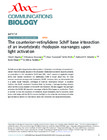The counterion–retinylidene Schiff base interaction of an invertebrate rhodopsin rearranges upon light activation
dc.contributor.author
Nagata, Takashi
dc.contributor.author
Koyanagi, Mitsumasa
dc.contributor.author
Tsukamoto, Hisao
dc.contributor.author
Mutt, Eshita
dc.contributor.author
Schertler, Gebhard F.X.
dc.contributor.author
Deupi, Xavier
dc.contributor.author
Terakita, Akihisa
dc.date.accessioned
2019-09-02T10:32:22Z
dc.date.available
2019-08-31T02:29:05Z
dc.date.available
2019-09-02T10:32:22Z
dc.date.issued
2019
dc.identifier.issn
2399-3642
dc.identifier.other
10.1038/s42003-019-0409-3
en_US
dc.identifier.uri
http://hdl.handle.net/20.500.11850/361671
dc.identifier.doi
10.3929/ethz-b-000361671
dc.description.abstract
Animals sense light using photosensitive proteins—rhodopsins—containing a chromophore—retinal—that intrinsically absorbs in the ultraviolet. Visible light-sensitivity depends primarily on protonation of the retinylidene Schiff base (SB), which requires a negatively-charged amino acid residue—counterion—for stabilization. Little is known about how the most common counterion among varied rhodopsins, Glu181, functions. Here, we demonstrate that in a spider visual rhodopsin, orthologue of mammal melanopsins relevant to circadian rhythms, the Glu181 counterion functions likely by forming a hydrogen-bonding network, where Ser186 is a key mediator of the Glu181–SB interaction. We also suggest that upon light activation, the Glu181–SB interaction rearranges while Ser186 changes its contribution. This is in contrast to how the counterion of vertebrate visual rhodopsins, Glu113, functions, which forms a salt bridge with the SB. Our results shed light on the molecular mechanisms of visible light-sensitivity relevant to invertebrate vision and vertebrate non-visual photoreception.
en_US
dc.format
application/pdf
en_US
dc.language.iso
en
en_US
dc.publisher
Nature
dc.rights.uri
http://creativecommons.org/licenses/by/4.0/
dc.title
The counterion–retinylidene Schiff base interaction of an invertebrate rhodopsin rearranges upon light activation
en_US
dc.type
Journal Article
dc.rights.license
Creative Commons Attribution 4.0 International
dc.date.published
2019-05-13
ethz.journal.title
Communications Biology
ethz.journal.volume
2
en_US
ethz.journal.issue
1
en_US
ethz.journal.abbreviated
Commun Biol
ethz.pages.start
180
en_US
ethz.size
9 p.
en_US
ethz.version.deposit
publishedVersion
en_US
ethz.identifier.wos
ethz.identifier.scopus
ethz.publication.place
London
ethz.publication.status
published
en_US
ethz.date.deposited
2019-08-31T02:29:13Z
ethz.source
SCOPUS
ethz.eth
yes
en_US
ethz.availability
Open access
en_US
ethz.rosetta.installDate
2019-09-02T10:32:34Z
ethz.rosetta.lastUpdated
2024-02-02T09:14:44Z
ethz.rosetta.versionExported
true
ethz.COinS
ctx_ver=Z39.88-2004&rft_val_fmt=info:ofi/fmt:kev:mtx:journal&rft.atitle=The%20counterion%E2%80%93retinylidene%20Schiff%20base%20interaction%20of%20an%20invertebrate%20rhodopsin%20rearranges%20upon%20light%20activation&rft.jtitle=Communications%20Biology&rft.date=2019&rft.volume=2&rft.issue=1&rft.spage=180&rft.issn=2399-3642&rft.au=Nagata,%20Takashi&Koyanagi,%20Mitsumasa&Tsukamoto,%20Hisao&Mutt,%20Eshita&Schertler,%20Gebhard%20F.X.&rft.genre=article&rft_id=info:doi/10.1038/s42003-019-0409-3&
Dateien zu diesem Eintrag
Publikationstyp
-
Journal Article [128936]

